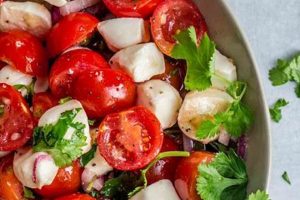A traditional Bulgarian salad combines fresh, diced tomatoes, cucumbers, onions, and peppers, topped with a generous layer of grated sirene cheese. Variations may include parsley or other herbs, but the core ingredients remain consistent. A simple vinaigrette, often just oil and vinegar, complements the fresh vegetables and salty cheese.
This dish offers a refreshing and flavorful experience, showcasing the vibrant flavors of the Balkans. Its simple preparation and readily available ingredients make it a popular choice for everyday meals, picnics, and celebrations. Rooted in Bulgarian culinary tradition, this salad reflects the country’s agricultural heritage and appreciation for fresh, seasonal produce. Its popularity has spread beyond Bulgaria’s borders, becoming a beloved dish in neighboring countries and beyond.
This exploration will delve into various aspects of this culinary staple, from regional variations and preparation techniques to nutritional information and serving suggestions. The following sections will provide a comprehensive guide to understanding and enjoying this classic dish.
Tips for a Perfect Shopska Salad
Achieving optimal flavor and texture requires attention to detail. The following tips ensure a delightful culinary experience.
Tip 1: Ingredient Quality: Selecting ripe, flavorful tomatoes, cucumbers, and peppers is paramount. Locally sourced, seasonal produce offers the best flavor profile.
Tip 2: Sirene Selection: Authentic Bulgarian sirene cheese is crucial for an authentic taste. If unavailable, a high-quality feta cheese can be substituted.
Tip 3: Vegetable Preparation: Dice vegetables into uniform pieces for even distribution of flavor and pleasing presentation.
Tip 4: Proper Salting: Lightly salting the vegetables before adding the cheese draws out excess moisture, preventing a watery salad.
Tip 5: Oil and Vinegar Ratio: A balanced vinaigrette complements the salad without overpowering the fresh flavors. A ratio of 3:1 oil to vinegar is recommended.
Tip 6: Fresh Herbs (Optional): A sprinkle of finely chopped fresh parsley adds a subtle herbal note. Other herbs, such as dill or mint, can be used sparingly.
Tip 7: Resting Time: Allowing the salad to rest for a short period after preparation allows the flavors to meld.
By following these guidelines, one can elevate this simple salad to a truly exceptional dish.
The following section will conclude this exploration with final thoughts and serving suggestions.
1. Fresh, High-Quality Ingredients
The emphasis on fresh, high-quality ingredients is paramount in a Shopska salad recipe. This salad, with its simple composition, relies heavily on the inherent flavors of its components. The success of the dish hinges directly on the ripeness and quality of the tomatoes, cucumbers, peppers, and onions. Using subpar produce results in a bland and less satisfying experience, diminishing the vibrancy that defines this Balkan classic. For instance, a tomato lacking sweetness or a cucumber with a bitter aftertaste can negatively impact the overall flavor profile. The choice of sirene cheese also plays a crucial role; authentic Bulgarian sirene offers a distinct salty tang that complements the fresh vegetables. Substituting with a lower-quality cheese compromises the authenticity and balance of the salad.
The impact of ingredient quality extends beyond taste. Fresh produce offers superior texture, contributing to the salad’s refreshing crispness. Locally sourced, seasonal ingredients, when available, often exhibit the most robust flavors and optimal textures. This connection to seasonality further underscores the emphasis on freshness within the culinary tradition. Consider the difference between a Shopska salad made with a vibrant, in-season tomato versus one made with a pale, out-of-season counterpart. The difference in flavor and texture is significant.
Understanding the crucial role of fresh, high-quality ingredients allows for a deeper appreciation of the Shopska salad’s simplicity and its connection to its agricultural heritage. Sourcing the best possible produce elevates this straightforward dish, transforming it into a celebration of fresh, vibrant flavors. This principle serves as a valuable lesson applicable to a wide range of culinary endeavors, highlighting the importance of ingredient selection in achieving optimal results. Prioritizing quality ensures a more satisfying and authentic culinary experience.
2. Authentic Bulgarian Sirene
Authentic Bulgarian sirene cheese forms an integral part of a true Shopska salad. This brined white cheese, traditionally made from sheep’s milk or a combination of sheep’s and cow’s milk, possesses a distinct flavor profile crucial to the salad’s overall balance. Its characteristic salty tang, slightly crumbly texture, and subtle lactic acidity contrast beautifully with the sweetness of the tomatoes and cucumbers, creating a harmonious interplay of flavors. Substituting sirene with other cheeses, even feta, while permissible, alters the authentic character of the salad. Feta, for example, tends to be creamier and less salty, resulting in a different taste experience. The unique characteristics of sirene contribute significantly to the Shopska salad’s distinctive identity, linking it directly to its Bulgarian culinary heritage.
The importance of using authentic Bulgarian sirene extends beyond mere tradition. The cheese’s specific properties interact with the other salad components in a way that other cheeses cannot replicate. Sirene’s lower moisture content prevents the salad from becoming watery, a common issue when using softer, wetter cheeses. Its firm texture also holds its shape well when diced or crumbled, maintaining the salad’s visual appeal. Consider a Shopska salad made with a soft, fresh cheese: the cheese might release excess whey, diluting the flavors and creating a less appealing presentation. In contrast, sirene maintains its integrity, contributing to both the flavor and texture of the salad.
Understanding the crucial role of authentic Bulgarian sirene provides insight into the nuances of this seemingly simple salad. While substitutions can be made, recognizing the specific qualities that sirene brings to the dish underscores the importance of ingredient selection in achieving an authentic culinary experience. This understanding translates to a deeper appreciation for the cultural and culinary significance of the Shopska salad, positioning it not just as a simple combination of ingredients, but as a carefully balanced composition with a rich history and distinct identity. Sourcing and utilizing authentic ingredients, whenever possible, allows for a more profound connection to culinary traditions and a richer understanding of flavor dynamics within a dish.
3. Precise Vegetable Dicing
Precise vegetable dicing plays a crucial, often overlooked role in a successful Shopska salad. Uniformly sized pieces ensure even distribution of flavor, allowing each bite to contain a balanced representation of tomatoes, cucumbers, onions, and peppers. This consistency elevates the sensory experience, preventing pockets of intense flavor or blandness. Furthermore, precise dicing facilitates even coating of the vinaigrette, ensuring that each ingredient is properly dressed. Consider the contrast: a salad with unevenly chopped vegetables might result in some pieces being overly saturated with dressing while others remain dry, creating an inconsistent flavor profile. Precise dicing also contributes to the salad’s visual appeal, enhancing its presentation. The uniformity creates a visually pleasing arrangement, showcasing the vibrant colors of the fresh produce.
Beyond flavor and aesthetics, precise dicing impacts the salad’s texture. Uniformly sized pieces create a harmonious mouthfeel, ensuring a pleasant chewing experience. Consider a salad with large chunks of tomato alongside thinly sliced cucumbers: the disparity in texture can be jarring. Consistent dicing, on the other hand, creates a balanced textural profile, allowing the individual textures of the vegetables to complement each other without one overpowering the others. This attention to detail, while seemingly minor, significantly contributes to the overall enjoyment of the dish. It transforms the salad from a simple combination of ingredients into a carefully constructed culinary experience, highlighting the importance of technique even in seemingly straightforward preparations.
The significance of precise vegetable dicing within a Shopska salad recipe underscores the interconnectedness of technique and outcome in culinary pursuits. While seemingly a small detail, it exemplifies the broader principle that careful preparation elevates even the simplest of dishes. This understanding translates beyond the Shopska salad, emphasizing the importance of precision in achieving desired results across a wide range of culinary endeavors. Whether dicing vegetables for a salad, mincing garlic for a sauce, or kneading dough for bread, attention to technique ultimately determines the final product’s success. Precise dicing, in this context, serves as a microcosm of the larger culinary landscape, reminding us that even seemingly minor details contribute significantly to the overall experience.
4. Balanced Vinaigrette
A balanced vinaigrette is essential to a successful Shopska salad recipe. The vinaigrette’s role extends beyond simply adding moisture; it provides a crucial acidic counterpoint to the sweetness of the tomatoes and cucumbers, while also enhancing the inherent flavors of the other vegetables. A properly balanced vinaigrette complements, rather than overpowers, the fresh, vibrant flavors of the salad’s components. An overly acidic vinaigrette can mask the delicate flavors of the vegetables, while a vinaigrette lacking acidity can result in a bland, one-dimensional taste experience. The balance hinges on the correct ratio of oil to vinegar, typically a 3:1 ratio, and the quality of the ingredients used. High-quality extra virgin olive oil contributes a fruity, peppery note, while a mild vinegar, such as red wine vinegar or apple cider vinegar, provides the necessary acidity. Consider, for example, a vinaigrette made with a strongly flavored balsamic vinegar: its intense sweetness might clash with the delicate flavors of the vegetables. Conversely, a vinaigrette made with an inexpensive, low-quality oil might introduce unwanted flavors that detract from the overall experience.
The practical significance of a balanced vinaigrette becomes evident in the final product. It provides a cohesive element, binding the individual flavors of the salad components into a harmonious whole. The vinaigrette also contributes to the salad’s textural appeal, adding a subtle gloss to the vegetables and preventing them from drying out. Furthermore, the emulsifying properties of the vinaigrette help distribute the flavors evenly throughout the salad, ensuring a consistent taste experience in each bite. Think of a Shopska salad dressed with just oil: the oil would coat the vegetables unevenly, resulting in pockets of intense oiliness and an unbalanced flavor profile. A well-emulsified vinaigrette, on the other hand, coats the vegetables uniformly, creating a more pleasurable sensory experience.
Achieving a balanced vinaigrette requires attention to detail and an understanding of flavor dynamics. The quality of the oil and vinegar, the ratio of ingredients, and the inclusion of any additional flavorings, such as herbs or spices, all contribute to the final result. Mastering this seemingly simple element elevates the Shopska salad from a collection of ingredients to a carefully composed dish, showcasing the interplay of flavors and textures. The principle of balance extends beyond this specific salad, serving as a fundamental concept in culinary arts. Whether creating a sauce, dressing a salad, or seasoning a dish, the pursuit of balance remains crucial for achieving a harmonious and satisfying culinary outcome. The Shopska salad, in its simplicity, provides a clear illustration of this principle, emphasizing the importance of balance in achieving culinary excellence.
5. Optional Fresh Herbs
While not strictly traditional, fresh herbs can enhance a Shopska salad recipe, adding a layer of aromatic complexity to the existing flavors. This optional addition allows for personalization and a nuanced flavor profile, building upon the foundational ingredients. Understanding the role and impact of fresh herbs provides further insight into the adaptability of this classic Balkan salad.
- Parsley:
The most common herbal addition, flat-leaf parsley provides a fresh, slightly peppery note that complements the other vegetables. Its bright green color also enhances the salad’s visual appeal. A small handful of finely chopped parsley, sprinkled over the salad just before serving, provides a subtle herbal lift without overpowering the other flavors. For example, using curly parsley, while visually appealing, can have a slightly bitter taste that might not complement the salad as well as flat-leaf parsley.
- Dill:
Dill offers a more pronounced herbal flavor, its anise-like notes adding a distinct aroma and taste. Dill pairs particularly well with cucumbers and feta cheese, making it a suitable, albeit less traditional, option for a Shopska salad. However, dill’s assertive flavor can easily dominate the delicate balance of the salad, so it should be used sparingly. A small amount of finely chopped fresh dill can provide a unique twist, but excessive use can overpower the other ingredients.
- Mint:
Mint introduces a refreshing coolness, its bright, slightly sweet flavor contrasting with the savory elements of the salad. While less common than parsley or dill, mint can provide an interesting counterpoint, particularly during warmer months. Similar to dill, mint should be used judiciously to avoid masking the other flavors. A few finely chopped mint leaves can add a refreshing touch, but too much can create an imbalance.
- Combination of Herbs:
A combination of herbs allows for a more complex flavor profile. For example, a blend of parsley and dill, or parsley and mint, can offer a balanced, multi-layered herbal note. Experimentation with different combinations can lead to unique and personalized variations. However, it is crucial to consider the individual flavors of each herb and how they interact with each other and the existing salad components. A poorly chosen combination can result in a muddled or unbalanced flavor profile.
The use of fresh herbs in a Shopska salad, while optional, offers an opportunity for culinary creativity and personalization. Understanding the flavor profiles and potential impact of different herbs allows for informed choices, ensuring that the additions enhance rather than detract from the salad’s overall balance. Whether adhering to tradition with parsley or exploring more adventurous options like mint or dill, the judicious use of fresh herbs can elevate the Shopska salad experience, adding a nuanced layer of flavor and complexity.
6. Proper Resting Time
Proper resting time, though frequently overlooked, constitutes a crucial step in a Shopska salad recipe. Allowing the salad to rest after preparation, ideally for 15-30 minutes, facilitates flavor melding and optimal texture development. This seemingly passive step initiates several key processes that enhance the final product. The salt draws out excess moisture from the vegetables, concentrating their flavors and preventing a watery salad. Simultaneously, the vinaigrette has time to permeate the vegetables, ensuring even distribution of flavor and a harmonious balance between the acidic dressing and the fresh produce. The flavors of the tomatoes, cucumbers, onions, peppers, and sirene cheese meld together, creating a more unified and complex flavor profile. Without sufficient resting time, the salad’s flavors remain disjointed, lacking the cohesive character achieved through proper melding. Consider a freshly prepared salad versus one that has rested: the former might taste as though the ingredients are simply tossed together, while the latter exhibits a more integrated, harmonious flavor profile.
The practical significance of this resting period extends beyond flavor development. It also impacts the salad’s texture. The slight wilting of the vegetables, caused by the salt and vinaigrette, results in a more tender, palatable texture without compromising the desired crispness. This subtle softening enhances the overall mouthfeel, creating a more pleasurable eating experience. Imagine biting into a freshly prepared salad with firm, almost rigid vegetables. The texture might be perceived as harsh or uninviting. In contrast, a rested salad offers a gentler, more harmonious texture, enhancing the enjoyment of the dish. Furthermore, the resting period allows the flavors of any added herbs to integrate more fully with the other ingredients, contributing to a more nuanced and complex aroma.
Understanding the importance of proper resting time highlights the dynamic nature of a Shopska salad recipe. It underscores that the preparation process extends beyond the active stages of chopping and mixing. This seemingly passive step, often omitted due to time constraints, plays a crucial role in flavor development and texture optimization. Recognizing the transformative impact of proper resting time elevates the understanding of this classic dish, transforming it from a simple assembly of ingredients into a carefully orchestrated culinary process. This principle extends beyond the Shopska salad, demonstrating the importance of patience and allowing flavors to meld in various culinary applications. Whether marinating meat, allowing a soup to simmer, or resting a salad, time itself becomes an active ingredient, contributing significantly to the final result. By embracing this understanding, one can elevate seemingly simple dishes, unlocking their full flavor potential and achieving a more nuanced and satisfying culinary outcome.
Frequently Asked Questions
This section addresses common inquiries regarding the preparation and enjoyment of this classic Bulgarian salad.
Question 1: Can feta cheese be substituted for sirene cheese?
While feta can be used as a substitute, it alters the authentic flavor profile. Sirene possesses a distinct salty tang and crumbly texture that differentiates it from feta. If using feta, opt for a firmer variety and consider adding a pinch of salt to approximate sirene’s saltiness.
Question 2: What type of vinegar is best for the vinaigrette?
A mild vinegar, such as red wine vinegar or apple cider vinegar, is recommended. Avoid strongly flavored vinegars like balsamic, as they can overpower the delicate flavors of the fresh vegetables.
Question 3: Should the vegetables be peeled?
Peeling the cucumbers and tomatoes is optional. Leaving the skins on adds texture and nutrients. If peeling, do so thinly to retain as much of the underlying flesh as possible.
Question 4: How long can Shopska salad be stored?
Shopska salad is best consumed fresh. Refrigeration can alter the texture and flavor of the vegetables. If storing, do so for no longer than a few hours in an airtight container.
Question 5: Can other herbs be used besides parsley?
While parsley is traditional, other herbs like dill or mint can be used sparingly. However, these herbs possess stronger flavors and should be added judiciously to avoid overpowering the delicate balance of the salad.
Question 6: What are the nutritional benefits of Shopska salad?
Shopska salad offers a good source of vitamins, minerals, and antioxidants. The fresh vegetables contribute vitamins C and K, while the sirene provides calcium and protein.
Understanding these common points of inquiry assists in achieving optimal results when preparing and enjoying Shopska salad.
The following section will offer concluding thoughts and serving suggestions.
Shopska Salad Recipe
Exploration of the Shopska salad recipe reveals a dish steeped in tradition yet adaptable to individual preferences. Emphasis on fresh, high-quality ingredients, proper vegetable dicing, and a balanced vinaigrette underscores the importance of technique and ingredient selection in achieving optimal flavor and texture. Authentic Bulgarian sirene cheese distinguishes the salad, contributing its characteristic salty tang and crumbly texture, although feta offers a viable substitute. Optional additions of fresh herbs, such as parsley, dill, or mint, allow for personalized flavor profiles. Finally, proper resting time allows flavors to meld, resulting in a more harmonious and satisfying culinary experience.
Shopska salad represents more than a simple combination of ingredients; it embodies a culinary tradition grounded in fresh, seasonal produce. Its enduring popularity speaks to its refreshing simplicity and adaptability. Further exploration of regional variations and culinary pairings offers continued opportunities for discovery and appreciation of this Balkan classic. Ultimately, understanding the nuances of a Shopska salad recipe empowers culinary enthusiasts to recreate and appreciate this vibrant dish, fostering a deeper connection to its cultural heritage and culinary significance.






